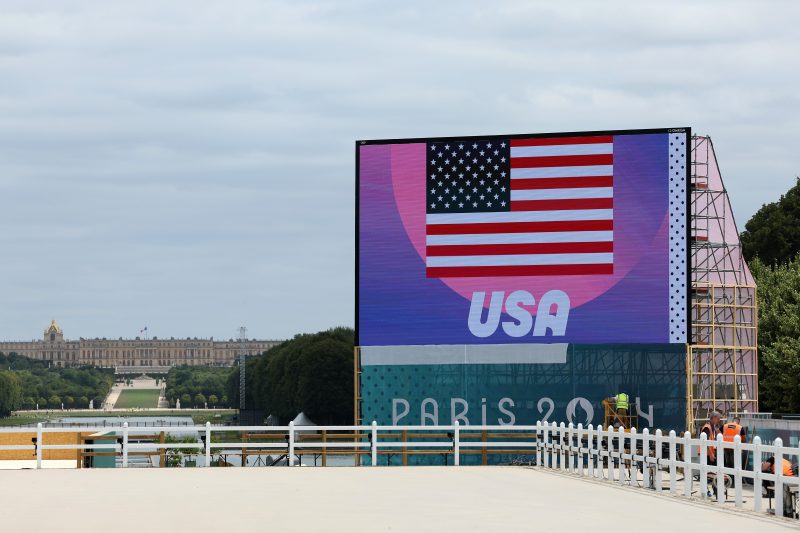King Louis XV once said “Après moi, le déluge.”
After me, the flood.
If only “The Sun’s King” knew what would eventually take place at the royal palace he commissioned more than four centuries after his death: the 2024 Paris Olympics. The Palace of Versailles will be the site of Olympic equestrian and Paralympic equestrian, as well as modern pentathlon, during the 2024 Summer Games – giving one of the most-visited tourist destinations in France (8.2 million visitors in 2023, 18% from the United States) another temporary distinction. After the Paralympics, there will be no sign of the transformation the 741 acres have undergone over the past two years.
Three grandstands constructed around the Etoile Royale can fit about 16,000 spectators. The cross-country discipline of equestrian will feature a 3.29-mile course with 27 obstacles. Another 40,000 seats will line the course.
Even with all of the changes, the setting of Versailles provides a heightened sense of history, said David O’Connor, who chairs the eventing committee within equestrian’s international governing body (Federation Equestre Internationale) and was heavily involved in the planning of the Paris Olympics.
Meet Team USA: See which athletes made the U.S. Olympic team and where they are from
“It’s a pretty stunning backdrop,” O’Connor told USA TODAY Sports.
How did Versailles turn into Olympic equestrian venue for Paris 2024?
Versailles has been a public establishment under the supervision of the French Ministry of Culture and the Ministry of Budget since 1995. To make the palace grounds suitable for Olympic competition, large-scale construction took place – which could have been a cumbersome and ineffectual process, considering Versailles has been recognized as a world heritage site by UNESCO since 1979.
At the 2012 London Games, which held equestrian events at iconic Greenwich Park, O’Connor said they couldn’t dig into the ground. Everything had to be built up.
“(At Versailles), they’re like, ‘No, we can do things and we’ll just put it back when we’re done,’” O’Connor said. “That’s a pretty remarkable thing for a historical preservation place.”
Working with the Palace teams – from architects, site supervisors, gardeners and fountain artisans to project managers, legal and administrative staff – has been easy enough. Organizers paid a lot of attention to improving the quality of the grass and mostly moving earth.
Builders wanted to clear underbrush, and park personnel told O’Connor that had been on the to-do list anyway.
“It’s dirt, and dirt that has been here a long time, and it’ll all go back,” O’Connor said.
The three-sided stadium looks out to the Grand Canal and the palace. During the cross-country portion of eventing and the jumping event, both the Grand Canal and the Royal Menagerie will be featured. Horses and their riders will traverse the canal twice via makeshift pontoons. They’ll jump into a large fountain near the Menagerie, which has a natural amphitheater that dates back to the 1600s.
“We’re jumping into the fountain, going across, jumping up a bank coming out of that area and having another fence,” O’Connor said. “So it’s a really cool exercise.”
The fences on the cross-country course are designed and painted in ways to honor the history of Versailles and the French style.
“It is beautiful, what the craftsmen have put together for the courses, within the shapes that we want for the horses and things like that,” said O’Connor, who is also U.S. Equestrian’s chief of sport.
Once the Paralympic competition wraps on Sept. 7, deconstruction and restoration of the grounds will begin. As with all temporary venues at Paris 2024, the goal is to return the setting to its pre-Olympic look.
“A year from now, you won’t even notice that we were all there,” O’Connor said.
Putting horses first for hundreds of years
Louis IV became interested in the grounds – 12 miles west of Paris – because he hunted on horseback in what eventually became Versailles and the surrounding area.
As many as 2,200 horses filled the royal stables at Versailles at its peak in 1787. The art of modern dressage was founded at the École de Versailles. A bronze statue of Louis XIV on horseback stands at the edge of the Place d’Armes. It was Louis IV who ordered the construction of the stables that were built between 1679 and 1682 opposite the palace’s main entrance.
Beyond the sense of history, O’Connor said, what amazes him is how they built an advanced stabling system in a short period of time during that era.
“Because of that number of horses, they’re on two levels,” he said, “and just the quality of that stabling, all built out of stone.”
The French army took over the stables following the French Revolution and housed cavalry regiments there through World War II, according to the Associated Press. They were essentially a storage facility for the Versailles district’s archives and horse carriages in the latter half of the 20th Century. In 2003, the National Equestrian Academy returned to the building.
The Olympic horses will be housed in a separate, air-conditioned facility beyond the Grand Canal – away from vehicle traffic, which is always a priority, O’Connor said.
“There’s a lot of places for the horses to be able to go out and graze and get out of their stalls and be able to walk around in a section of the park that the public won’t have really access to, and will kind of have their own quiet zone to be able to get out and roll,” O’Connor said.
Versailles will remain open to the public during the Games. From July 2 to Nov. 3, the palace will hold an exhibition dedicated to horses and equestrian civilization in Europe to honor the Olympic event taking place on its grounds.
“It’s all right there in front of you when you go look around,” O’Connor said, “and it’s pretty amazing.”

